|
SPOTLIGHT INTERVIEW 2005 - Dr. Zahi Hawass
Guardian: It's wonderful to see the King Tut exhibit finally returning to the US. I seem to recall that in the 70's there were some problems with the exhibit coming through, things were damaged? Dr. Hawass: Yes, you know the exhibit came to the states here 26 years ago and actually at that time I think the ticket was $1. And now the tickets are $30. Now, what happened when the exhibit came here actually Egypt did not get anything. All museums got the money, selling the souvenirs at the shop, the museum is still selling replicas until now in the name of King Tut and Egypt got zero. And you know, museums here are making small things, but in Egypt we have restoration of the pharaonic and Greco-Roman monuments and the Islamic museums, you know big things that we need really money.
Therefore, when the exhibit left the United States 26 years ago then it went to Germany and the craters were trying to put one of the shrines with the Goddess Selket and there was a scorpion at the top of Selket, it fell down, it was broken. Then the Parliament of Egypt discussed that and they decided that King Tut cannot travel. Guardian: That's what I thought.
We are building 19 museums for the first time and actually these museums are like specialist Museums, like the Akenaton Museum in Minia, the Coin Museum in the Citadel. Guardian: What about the new Imhotep Museum? Dr. Hawass: The Imhotep Museum is a site museum which we are opening this month and also, the site Museum in Kom Ombo for crocodiles. We are building museums in Sharm El Sheik and Hurghada. We are opening the Coptic Museum this month after after a renovation, the Islamic Museum in March. We are closing the Graeco-Roman Museum for 2 years. In Cairo we are building the largest Museum in the world. The construction will start about 2 months from now. It will be the largest museum in the world of pharaonic monuments, it will by the shadow of the pyramids about 116 Feddans (50 hectares = 280000 sq. m.). The loan for this Grand Museum comes from Japan. and we are really actually going to build another Civilization Museum in Fustat, a big one, and the Cairo Museum will be a museum for artists. It's a big revolution for museums. We're changing museums for the first time from more storage oriented to more beautiful displays. If you go to Luxor and see the extension that we did to the museum it's incredible.
We are doing also more protection for the sites, more site management. For every site we'll have a safe zone that is protected, a Visitor Center to explain the site, access to tourists. We are also having conservation training and outside shops, clean bathrooms, and we did make the Island of Kalabsha, the unfinished obelisk in Aswan, Temple of Edfu, Kom Ombo, Abydos, we are working in the Valley of the Kings, complete development now, and the pyramids. And in 2 years I will finish all the sites. At the same time we are doing a kind of guarding the monuments for the first time. We built, for the protection of the monuments, 33 storage museums all over Egypt to change this primitive storage that we have, 500 primitive storage sites. And we moved this now to the new storage that everyone can visit. We are changing the Egyptian law for the first time that anyone that steals monuments it will be a serious crime. We are also recording the monuments that are not recorded. And we also at the same time are doing programs of awareness for the Egyptians, to teach the kids and adults about Egyptian history. We take the kids to the Cairo Museum, and for adults we have a school at the Cairo Museum, and we make "Friends of the Museum" programs, its a big thing in Egypt now. And lastly, returning our stolen artifacts. Guardian: So each of the sites such as Kom Ombo will have their own Visitor Center? Dr. Hawass: Yes. Edfu has one, Kom Ombo doesn't because Kom Ombo now you come from the water up to the temple, now you enter the temple from the main entrance, not from the back. You come from the water and you go straight up to the temple. After you visit the temple you go to a small museum about crocodiles. Edfu is also incredible. You don't see this primitive thing of galabeyas above the temple, no, you go to the main entrance of the temple and all the shops have been arranged with a Visitor Center with a film done by the National Geographic this week. It will be in the Center this month. Guardian: Now you saying that the King Tut exhibit may possibly come back here to the States? Dr. Hawass: I'm thinking actually to return Tut back after London in 2007 it will be here in 3 cities. I'm thinking about the 3 cities. Guardian: Is there any plans in the future for other exhibits to travel? Dr. Hawass: And the most important thing that we are really thinking to stop sending exhibitions. But to make "Cairo Museum" in cities like New York and London. I'm searching to make a permanent museum, belonging to us. Egypt should make the money for the restoration of the monuments. And I'm thinking of building a permanent museum in the States, in London, in France and to have great artifacts like King Tut and things like this. But we have an exhibit now open this month in Madrid, it's called, "The Pharaohs", its about the pharaohs of ancient Egypt. Guardian: Which pieces are in that? Dr. Hawass: We have pieces of kings and queens, nobles and officials, and beautiful statues. It's opened on the 17 of December. And also we are sending an exhibit to Japan. It's called Cleopatra, actually Cleopatra is becoming something very important now and I never thought I would search for her. Now we are working in a temple near Alexandria called Tabusiris Magna and we think that maybe Cleopatra is buried in the most sacred place inside this temple. We are excavating now, we've stopped the excavation for 1 month, and we're going to open the excavation on January 15th to search for Cleopatra again.
Dr. Hawass: I did not participate, I was the head of the expedition, and now we did the CT scan of King Tut and we are starting next month a major important project. Actually to do the CT scanning of the non-royal mummies. Then we can understand about diseases and how the Egyptians died and ages and things like that. And after that we will do the Royal mummies. Every Royal mummy in the museum will be under the CT scan. We are going in 2 years to move all these mummies from the Cairo Museum and the Civilization Museum in Old Cairo. And every mummy will be educational by its own, we will not show the mummies like now for thrill, we'll have the mummy, and after the mummy, we'll have the history of what the king did and after that a big room with the CT scans. I have to tell you that when I went for the first time to the Valley of the Kings to do the CT scan of King Tut, it was one of the most important moments in my life. Really it was amazing, even if you look at the mummy of King Tut you'll find that it is completely deteriorated because Carter when he began to take the golden mask out he damaged the mummy completely. But still, looking at his face, with the elongated head, having the buck teeth like Tutmosis II and Tutmosis III, was a very interesting experience and you have to know that when I was in the Valley of the Kings I did take the opportunity to CT scan the other mummies, like the three mummies left in the tomb of Amenhotep II.
One of them you know this lady Joann Fletcher really advertised everywhere that this was the mummy of Nefertiti. But actually we went and we did examine that mummy, we found that the mummy has no evidence at all that could be Queen Nefertiti. But we did CT scan of the mummy of the elder lady, you know that some people believe it ws Queen Tye, and the mummy of the boy, that some people believe its the son of Amenhotep II. Also we took one mummy of a child that, its a royal mummy, inside the tomb of Tutmosis IV. And we did CT scan it. And, the mummy number five its the mummy of the king that we've not identified, in the tomb of Seti II. The last mummy which is not identified its in the KV 60, and KV 60 has no inscription. Its next to the tomb of Hatshepsut, and inside KV 60 found this mummy and beside the mummy found the coffin of the wet nurse of Tutankhamun. And actually this mummy many people believe its for Queen Hatshepsut. But this mummy I am going in a month from now to go the Valley of the Kings and do an important study of that mummy with a CT scan and maybe we can reveal something about Hatshepsut. Guardian: Do you do DNA tests as well? Dr. Hawass. We do not do DNA because DNA proved not to be very correct, there's 40% error. I don't really want people to do DNA with mummies and to make speculation. Its very important that if you do DNA, it should be accurate 100%, and therefore we are not going to do any DNA to any mummies unless its completely accurate. Guardian: Now you returned the mummy of Ramses I to Luxor? Dr. Hawass: Yes. |
|||
|
|
Guardian: Are there more mummies going to be returned there? Dr. Hawass: No, I returned this mummy to Luxor because I did the at Luxor Museum an important exhibit about the army in the golden age. And that is showing really the glory of Egypt during the New Kingdom. And I thought I should take two important kings. One is actually the mummy of Ahmose I who dismissed the Hyksos, and the second is the mummy of Ramses I because he was one of the military kings. And I thought I brought it from Atlanta and I thought it would be very important for this king to be near his tomb because he has been away from Egypt for more than 150 years. But
|
||
|
actually when I arrived to Luxor with this mummy, and with me was Ahmose, no one really gave any attention to Ahmose, everyone gave attention to this mummy, it wasn't ever in the Cairo Museum, and now it in the inside the museum in Luxor.
Guardian: Is that permanent? Dr. Hawass: Permanent. Guardian: I know you're trying to get more qualified Egyptians into the excavations, how's your progress with increasing participation? Dr. Hawass: Very well! You have to know now that the excavation schools that we are doing now, we have like now 250 young people, well educated, in the field of excavation techniques. And those are very important because excavation in the future, when they excavate, they will do good work because wrong excavation can destroy history. At the same time, I want Egyptians to put qualified scholars in the field of excavation. And look what I did, I'm working now in Saqqara actually in an excavation, actually with all my busy work I still do field work, and the most important field work that I'm doing right now actually is searching for the lost pyramid at Saqqara of a king called Meri Kara, and that king is dated to Dynasty 9 after the Old Kingdom, and we believe that his pyramid existed there and this pyramid I am sure we will discover it in a week or two from now. We are still excavating near the pyramid of Teti, also the excavation at the Valley of the Golden Mummies, and at the Workman's tombs. But the most important thing at Giza actually - that there are 2 tombs that we found last year that I have not opened yet. One was found cut on the rock of the causeway of the 3rd pyramid of Menkaura. I found out when the Egyptians restored the causeway they did restore it and there was an existing tomb and they closed the tomb then maybe this tomb is intact. I will open this tomb in January or February. The second tomb is between the Sphinx and the 2nd pyramid, I am excavating this area, are tombs dated to Dynasty 26. And one tomb I found, we went down in the rock and we actually went for about 30 feet, and after that we found 6 rooms, under the ground, cut in the rock, in one of them a wooden box contained 400 shawabtis, small statues, but we did not excavate the burial chamber yet. But I feel its intact. We are going to open this soon.
At the same time you know for the tomb of Seti, this tunnel that goes inside the tomb. I went last year inside for about 260-270 feet and we still had to enter until 300 feet. But I will do a restoration, piece by piece, until I can go to the end and maybe the second tomb of Seti existed. Because you know when I was a young boy, around 35 years ago, I met this man, Sheikh Aly, from the Abdou El-Rasoul family and he took me from my hand to the tomb of Seti, he pointed out in that shaft and he said, "at the end of that shaft the burial chamber of Seti I existed" and he said, "maybe one day you'll be an important archaeologist and you can help me with that".
The man died, and when I became the head of antiquities I thought that I should see about that. And I went recently, I can show you a photograph I will send it to you, that shaft was so dangerous it goes on slope, some drop you can fall down, and I went for about 270 feet. But I will start next year doing some conservation and restoration to the end, and maybe we can find something. Actually, the year 2006 is going to be a very important year for us, for our culture. We're doing lots f important things. And the most important thing of course is the secret doors of the pyramid. Last year I had a meeting with a man from Hong Kong, a scientist. Guardian: I just put up your recent article about this on your website. It's called "The Robot and the Secret Door". Dr. Hawass: On December 22nd are having another meeting I think I wrote about this in the article, I'm meeting with this man from Manchester and another man from Hong Kong, and Farouk El-Bas and myself, and a team from the faculty of engineering from Cairo University, we'll decide actually about this robot. And we'll see cause we really have to find out how can we go through the 2nd door and the third door, then it still need lots of studies and lots of important things like this. Guardian: It's very exciting and there's lot of public interest about this. Will you do that live on television again? Dr. Hawass: I really don't want to do it live, cause we need to do scientific work first. To do live its lots of hassle and difficult things. Guardian: Like a circus really. Dr. Hawass: Yes, you need to do the work first and after that if there's something important maybe you can do it live. Guardian: I know that you were performing some clearance work around the Pyramid of Teti at Saqqara, was there anything of significance found during that clearing?
Guardian: That's very exciting. The pyramid of Unas, does that remain closed to the public? And probably will stay closed? Dr. Hawass: Yes. Guardian: What are some of the more recent discoveries at Saqqara over the last few weeks or months? Dr. Hawass: Alain Zivie discovered the tomb of the wet nurse of Tutankhamen you know that. And having Tutankhamen and his nurse on her lap. And Christiane Ziegler from the Louvre, she found also some shafts that dated to the Graeco-Roman period, and the 26th dynasty, full of mummies. Guardian: Last time I spoke with you it was mentioned that a few of the sites might be soon opened to the public shortly, Abu Roash and Abu Sir. Has this occurred? Dr. Hawass: Actually we are opening Abu Sir, we just have to do something with the security and the site will be opened after I go back. Guardian: Will that site have a Visitor Center? Dr. Hawass: The Visitor Center for Abu Sir is not so important. But Saqqara has a Visitor Center now with the Imhotep Museum. After I open Abu Sir, we are going to work in the two sites of Abu Roash and Lisht. Guardian: With intention of opening them both? Dr. Hawass: Yes, in the year 2006, the two together. But at the same time you know we are opening tombs in Luxor, and closing tombs, we are doing now the rotation system to accommodate between the load of tourists and the preservation of the monuments. Guardian: And how's that working out because I know that you instituted the rotation system, are you finding that you are having less damage by keeping monuments closed for these periods of time? Dr. Hawass: Yes, like the Great Pyramid. We are closing the third pyramid now. Guardian: When will this re-open? Dr. Hawass: In about 6 months, then we will close the Great Pyramid after, because the Great Pyramid was not really closed since 1993. Guardian: You mentioned that you might open some tombs in the Valley of the Kings, and close others. Which will open and which will close for the rotation? Dr. Hawass: We are first building the Visitor Center now in the Valley of the Kings. Guardian: When will that be completed? Dr. Hawass: In February, completely, it will be beautiful. Guardian: Is that going to be where you take the buses from, that main area? Dr. Hawass: Yes, and beside that we'll have a parking lot for the buses, we are building it now, cafeteria, a whole area, and in the Visitor Center we will show a film about old photographs of the Valley, owned by the Metropolitan Museum. After that, we'll light the Valley of the Kings, then we can make the visits to the Valley of the Kings be by time, by reservation, in the morning, the afternoon, and in the evening. And we're doing protection of the tombs. After that, we'll do the rotation system. We'll publish a catalog for ten years, what really you can see this year and next year and so on, the rotation system. Guardian: You'll let me know when you have that and we'll put that up on the website. Dr. Hawass: Exactly, yes. Guardian: Are you continuing to clear the Bent Pyramid at Dahshur? Dr. Hawass: Rainer Stadelman is working inside this pyramid now. Guardian: There's a German concession there now? Dr. Hawass: Yes, I hope, cause I really still believe that Sneferu is buried in this pyramid. Guardian: Have they built any ramps or stairs to gain access to the main burial chamber? Dr. Hawass: No, we are not going to open it to the public yet. Guardian: So they're cleaning it out and cataloging it? Dr. Hawass: Yes. Guardians: What is the status of the site management project at Giza? I know that you had spoke about moving the boat museum, building a wall and a visitor Center. Dr. Hawass: The wall has been built, 17 kilometers around the pyramid. We also at the entrance of the Mena House, in a month from now, we are going to open it, after we made a parking lot down and we have have security for the tourists and clean bathrooms, and this will be a beautiful entrance by the Mena House. And after that we will go to the south of the pyramid to finish the stable for the horses and the other things that we will do for the finishing of the whole project. Guardian: I know this keeps getting delayed, have you finally pulled all of the vendors and the camels off of the plateau? Dr. Hawass: We will after we open this and have built the stables in the south of the third pyramid. Guardian: Do you have any updates on Bahariya? How often are you going there now, you used to go there every week? Dr. Hawass: Yeah, we have stopped the excavation now at the Valley of the Golden Mummies, but we are going to continue now the excavation in the area of the Governor's tomb cause we found this year the tomb of his brother, who was a priest, and with a big sarcophagus and the shaft was sealed. We are looking this year which we hope we will finish it, it will be be the end of the excavation because we will be finding the whole family now, It is the Tomb of Shepsu-Khonsu, who was the brother of the governor. Guardian: You received a prestigious award from the American University on Cairo, what was that like for you? Dr. Hawass: It was very nice, it was a doctorate, honorary degree. It was very nice to receive it and it was nice also to nice to give the speech to the students. Guardians: Having been the Secretary General for the past three years now, what has changed your mind, now that you've had this position? Dr. Hawass: Since I came to this position I had a vision and I'm doing it very well. And that vision will show people for the first time how our museums are going to be different now. We began to have personality for the Egyptian archaeologists, before they did not, because it was only the foreigners who do every thing. I really began to see that the training of the second generation has been very important. Like I'm sending young people now, Tarek (El Awady) is coming back, and Mahmoud Afifi is coming back; I sent him to Poland, and Tarek, my assistant, I sent him to Prague, Hussien to America, Ramadan to Brown University, all these people will come back and I hope that they can really help me and try to do something for the Egyptian Archaeology. Because I have to tell you that the most important thing is that we really have to have people who have knowledge, because people who know can really do good things. And this is why I really concentrate mainly on the training, on the excavation techniques, and museums. We are opening a school to teach people because craters are very important. The basement of the Cairo Museum needs lots of work, and I'm starting the conservation of the basement soon, and it will take one year to change this maze of corridors that house thousands of artifacts that no one knows anything about them. And we started a database for the Cairo Museum for the first time. Guardian: I was wondering about that, there are a lot of things down there, for so many years that nobody knows about, it seems astounding. Dr. Hawass: No one knows anything about this. Guardian: I have my own vision that what you are doing ultimately will set an example for the rest of the world regarding how to take care of antiquities. Dr. Hawass: I have to tell you that what we are doing in Egypt, that there is no other country that is doing it like that, no way. With all this major site management program, with all of these museums, all of this, its really unique. Guardian: You're to be commended. I call myself Guardian for my website for all of these years, taking responsibility to "guard" or present and report, accurately and responsibly, the work being done in Egypt, but really it is you who are the Guardian of all these monuments and antiquities. And you're to be commended on this. Dr. Hawass: (smiles) Thank you!
Guardian: I have to ask you some of these questions that we constantly get on the website from youngsters who are interested in fascinated in Egyptology. What's the most gratifying thing that you have experienced since becoming the Secretary General? Dr. Hawass: I have to tell you that every minute in my life there is an action. I have to say this. Every second there is something that is going on. I just finished a book last week called the "Mountains of the Pharaohs" to be published. I'm writing another book now called the "Royal Tombs: Gateway To Eternity". There is a book coming about Giza and the Pyramids. Also I wrote a book about Dynasty 4 and Khufu. But you know for me, I think what really I can say right now is the moment that I met Tutankhamun, face to face that was something I really think about.
Guardian: I could tell when I saw you on TV that I could feel that what you were feeling, that this was really a great moment for you. But being Secretary General, you can basically do whatever you want, you have to stay within the law, what have you really been able to accomplish so far that you really wanted badly? Dr. Hawass: The thing that I really talked to you about in the beginning, is really what I dreamed to do with museums and site management, protecting our monuments, and returning stolen artifacts. Guardian: How is that going? Are you going to get the Rosetta Stone back to Egypt? Dr. Hawass: We are talking to UNESCO now to return it back. Guardian: Does it look like that might really happen? Dr. Hawass: I wrote to UNESCO to return the five masterpieces, and now we are waiting for a response. We are going to bring the countries that have ancient civilization like Iran, Iraq, China, Greece, Rome, all these people to meet in Cairo, and each country should ask about the unique artifacts that they want to be back. Each country should offer maybe at least 3 - 5 artifacts, and we'll come to an international list. Because we do not want every artifact to come back, we need only the unique artifacts to come. Guardians: Do you miss being Director of the pyramids? Dr. Hawass: I still am. Guardian: There's nobody that has been assigned to this after you became Secretary General? Dr. Hawass. There is somebody appointed to do the progress work, but I am still the Director of the excavations at the pyramids, and I still have my office there, and I still have everything. It is still one of my offices, my main office is in Zamalek. Guardian: We get a lot of letters, as you've seen, from your Fan Club from youngsters, and a lot of them ask a similar question which is, "what is your best advice to someone who wants to become an Egyptologist"? Dr. Hawass: You know the best advice that I have to tell the young people, its very important to study, to go to whatever Universities to study Egyptology. But after he/she has to come to have the passion. If he/she has a passion inside, they can do it. You need to have it to do it well. If you don't have the passion you will not do it well and you will not feel it. Because I am, as I told you, my mind is working with the pharaohs every five minutes of my life, there is something inside. You cannot do that without having the passion. If you take it as a job and just to do some excavation for fun and to discover something, I think that is not enough. Then for me, if they've followed my career, I started studying, and studying, and studying, to become good. If you become good you will do good things, and after that passion will come to you. Guardian: So training and passion, pretty much that's the important combination. I think that's very good advice. Dr. Hawass: Yes, yes! Guardian: I have one other question that we constantly get. And obviously many of these people have little or no training. Lots of people ask, both young and old, including recently a 50-year old woman, that they want to come to Egypt and participate in an excavation. So, what is your policy for a person, perhaps completely unqualified, to come to Egypt to volunteer on an excavation? Dr. Hawass: If some person is really dying to do that, and he can support his self or herself, we can use this person for a short period of time. Guardian: Generally how long a period of time? Dr. Hawass: Oh, a month, it depends what this person wants to do. They should write to me with their qualification and I can look at this. Guardian: And pretty much invariably they would pay their own way? Dr. Hawass: Yes. Guardian: There's not very many people who are in your position, you're famous, you've been around for a long time. When people get to your high position they often distance themselves from the public. I think its very admirable that you've created a Fan Club on your website to allow children and others to ask questions of you, and I know they appreciate it too. Dr. Hawass: Now I tell everyone about this website and people open it now. When I write to answer people from the Fan Club they get to read my responses on the website. This way many more people get to interact with me. Guardian: Well it was a pleasure, as always. Thank you! And I look forward to our next interview in Egypt. Dr. Hawass: Thank you also, and I look forward to it as well.
|
|||

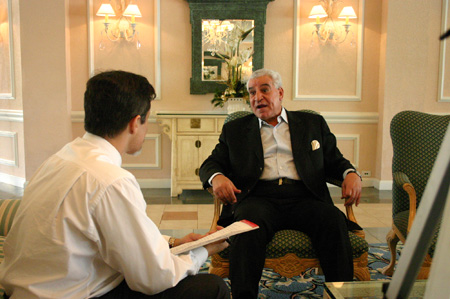
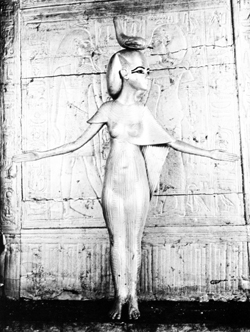
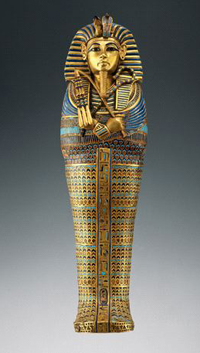 Dr. Hawass: Then myself and the
Minister of Culture went to the Parliament and we talked to them that this
time really we need to send King Tut and we can make money for the
restoration of the monuments. Then we gave the exhibit to Basel
(Switzerland), and after that to Bonn (Germany) and after that we made a
deal with the AEG and the Art and Exhibitions to take the exhibit and
support it by the National Geographic and I have to tell you I think this
exhibit, it is the best that has ever happened in history because if you
think that everyone in Los Angeles is paying $30, and there is only a few
thousand less that 1 million visitors, and when it was $1, 26 years ago,
it was million, two hundred thousand visitors who saw the exhibit, and so
actually this is the most fantastic exhibit to ever happen in history. Its
going after the Los Angeles opening now, this is the first time for King
Tut to come to Ft. Lauderdale, its going after that to Chicago, at
the Field Museum, and after that it will go to Philadelphia. And I really
picked towns like Philadelphia which are very special to me, I lived
several years, obtained my doctorate from there, and after that it will go
to England. And I'm thinking, since it became very popular in this
country, I'm thinking after England to return it back, maybe for three
cities, I did not decide yet. But actually if we are making now $9 million
a city, and that really I can use to do lots of good work now for the
first time in Egypt.
Dr. Hawass: Then myself and the
Minister of Culture went to the Parliament and we talked to them that this
time really we need to send King Tut and we can make money for the
restoration of the monuments. Then we gave the exhibit to Basel
(Switzerland), and after that to Bonn (Germany) and after that we made a
deal with the AEG and the Art and Exhibitions to take the exhibit and
support it by the National Geographic and I have to tell you I think this
exhibit, it is the best that has ever happened in history because if you
think that everyone in Los Angeles is paying $30, and there is only a few
thousand less that 1 million visitors, and when it was $1, 26 years ago,
it was million, two hundred thousand visitors who saw the exhibit, and so
actually this is the most fantastic exhibit to ever happen in history. Its
going after the Los Angeles opening now, this is the first time for King
Tut to come to Ft. Lauderdale, its going after that to Chicago, at
the Field Museum, and after that it will go to Philadelphia. And I really
picked towns like Philadelphia which are very special to me, I lived
several years, obtained my doctorate from there, and after that it will go
to England. And I'm thinking, since it became very popular in this
country, I'm thinking after England to return it back, maybe for three
cities, I did not decide yet. But actually if we are making now $9 million
a city, and that really I can use to do lots of good work now for the
first time in Egypt. 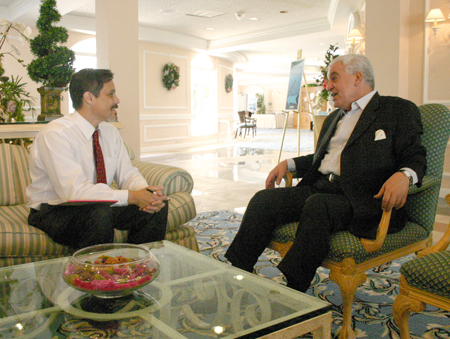
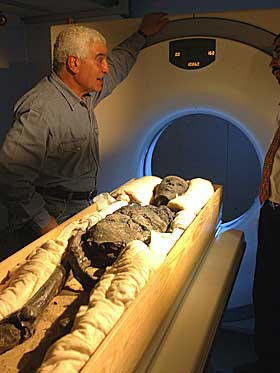 Guardian: Tell me a little of
what it was like to participate in the recent examination and CATscan of
King Tut's body?
Guardian: Tell me a little of
what it was like to participate in the recent examination and CATscan of
King Tut's body?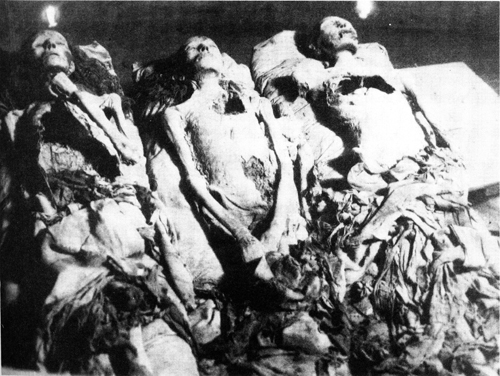
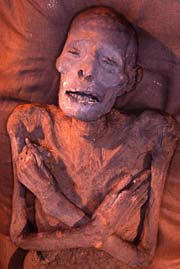
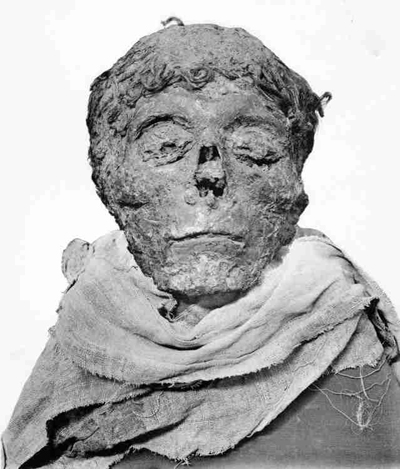


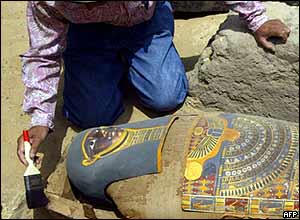 Dr. Hawass: We only found this
mummy, I sent this to you for the website, the beautiful mummy. We did not
really find major, but I'm looking near Teti now for this pyramid of Meri
Kara.
Dr. Hawass: We only found this
mummy, I sent this to you for the website, the beautiful mummy. We did not
really find major, but I'm looking near Teti now for this pyramid of Meri
Kara. 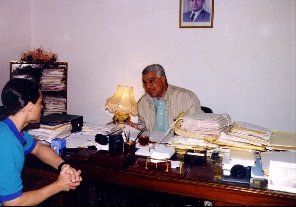
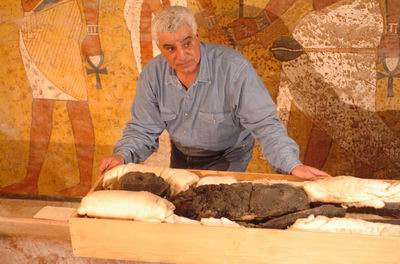
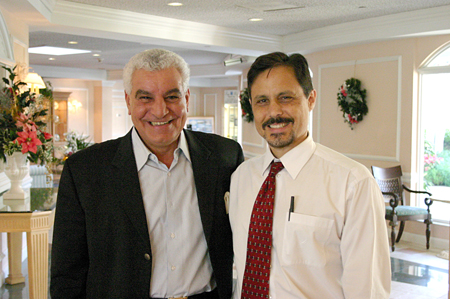
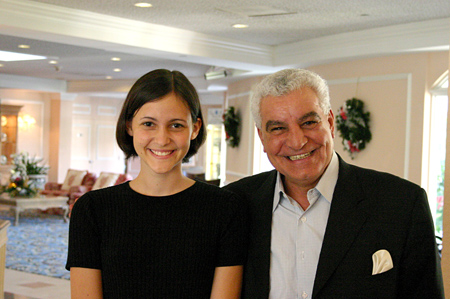
 RETURN TO
Guardian's Egypt Main Gate
RETURN TO
Guardian's Egypt Main Gate